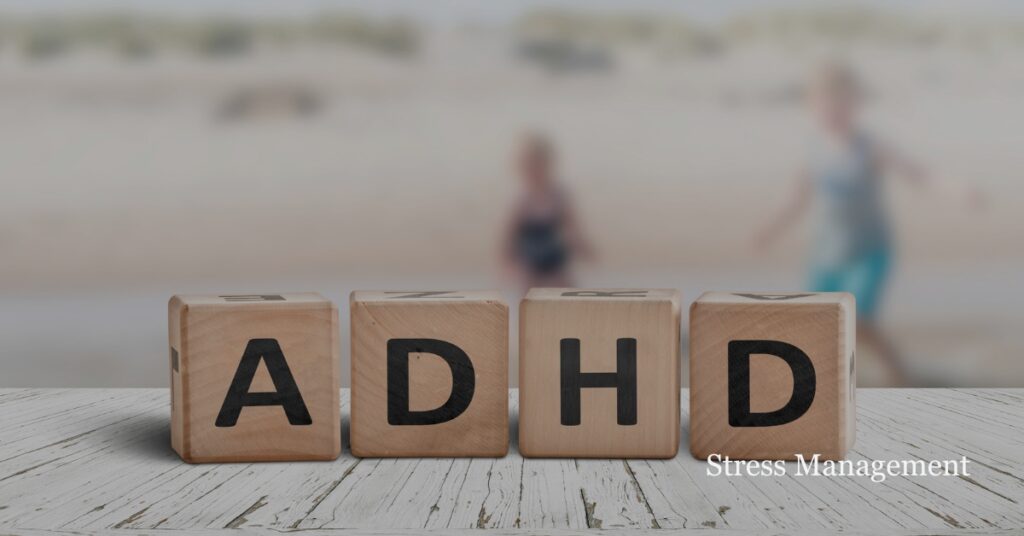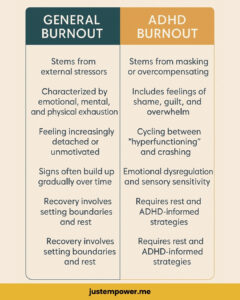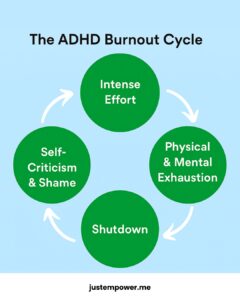If you’re living with ADHD, you may be all too familiar with the cycle of feeling “on” all the time—hyper-focused, overcommitted, stretched thin—and then crashing hard. This is what we often refer to as ADHD burnout.
But what is ADHD burnout exactly? And how is it different from general burnout? In this blog post, we’ll unpack the signs, symptoms, and causes of ADHD burnout, and share supportive strategies you can use to feel more grounded and less overwhelmed.

What is ADHD Burnout?
ADHD burnout is a state of emotional, mental, and physical exhaustion that happens when someone with ADHD has been pushing themselves too hard for too long—often in an attempt to keep up with neurotypical expectations.
It’s the result of trying to “mask” ADHD traits, overcompensate for executive dysfunction, and juggle responsibilities without proper support or self-regulation strategies.
While burnout can happen to anyone, ADHD burnout tends to be more intense, more cyclical, and more tied to self-worth.
What Is the Difference Between ADHD Burnout and Normal Burnout?
The biggest difference lies in the root causes and how it presents. Normal burnout often stems from external stressors—like a demanding job or poor work-life balance.
ADHD burnout, on the other hand, is often a result of internalized pressure to “do more” and “be better” despite the executive functioning challenges that come with ADHD.
With ADHD burnout, people often feel a deep sense of shame or frustration. You may wonder, Why can’t I just keep up? Why do everyday tasks feel so impossible sometimes? This emotional toll can make recovery more complicated than traditional burnout.

The Difference Between General Burnout and ADHD Burnout (with Jenna Kutcher’s Story)
Burnout is something many of us are familiar with — a state of emotional, physical, and mental exhaustion caused by prolonged stress. But for those with ADHD, burnout can look and feel very different.
General burnout typically comes from overworking, chronic stress, or lack of work-life balance. It tends to build over time and is often tied to responsibilities like work, caregiving, or ongoing emotional labor. Recovery usually involves rest, boundary-setting, and support.
ADHD burnout, however, is more cyclical — part of a recurring loop that stems from living in a world not designed for neurodivergent brains (Source). It often follows this pattern: masking or overcompensating to appear “neurotypical,” hyperfocusing and overextending beyond what’s sustainable, followed by complete mental, emotional, and physical exhaustion. This is known as the ADHD burnout cycle, and it’s frequently misunderstood as laziness or lack of discipline.
Jenna Kutcher’s story offers a powerful glimpse into how ADHD burnout can show up — even in high achievers. Before being diagnosed, she frequently beat herself up for things like procrastinating simple tasks (like opening mail or renewing a passport), struggling with organization, or feeling overwhelmed by the very idea of cleaning up a mess. She describes how she would function well amidst “little piles” but become overstimulated or anxious when systems were imposed that didn’t work for her brain.
These aren’t just quirks — they’re signs of a brain working overtime to manage executive dysfunction, which often leads to ADHD exhaustion and eventually ADHD burnout. While Jenna’s creativity and entrepreneurial spirit thrive in a self-led environment, the invisible toll of trying to keep up with the expectations of a neurotypical world eventually caught up with her.
She talks openly about how receiving her diagnosis felt liberating — not because it “fixed” anything, but because it helped her reframe the shame. What once looked like character flaws (“Why can’t I just do the simple thing?”) now had an explanation. That self-awareness has allowed her to find more sustainable ways to work, manage her energy, and advocate for support.
Key Differences at a Glance:
| General Burnout | ADHD Burnout |
| Caused by chronic stress, often related to workload | Caused by masking, hyperfocusing, and managing executive dysfunction |
| Gradual onset | Repetitive, cyclical, and often rapid onset |
| Can often be relieved with rest or time off | Rest may help, but deeper strategies are needed to prevent reoccurrence |
| More recognized and validated in workplaces | Often misunderstood or dismissed due to hidden nature |
| Affects productivity | Affects identity, motivation, and executive functioning deeply |
What Does ADHD Burnout Feel Like?
For many, ADHD burnout physical symptoms can include migraines, fatigue, sleep disturbances, and heightened sensitivity to sound, light, or touch. Mentally, it may feel like being frozen — unable to start or complete tasks, no matter how important they are. Emotionally, you may feel shame, frustration, hopelessness, or anger at yourself for not being able to “just do the thing.”
This intense shutdown is not laziness — it’s the crash after running at 150% for too long.
Symptoms of ADHD Burnout
ADHD burnout doesn’t always look like lying in bed all day. It can be sneaky and come in waves. Common signs include:
- Feeling constantly overwhelmed or on edge
- Difficulty starting or finishing tasks (even ones you enjoy)
- Physical symptoms like fatigue, headaches, or muscle tension
- Emotional outbursts or heightened sensitivity
- Struggling to manage time or keep up with basic routines
- Losing interest in hobbies or socializing
- Persistent feelings of guilt, shame, or failure
These ADHD burnout physical symptoms can mimic anxiety or depression—and often overlap—so it’s important to explore how burnout might be showing up in your body, too.

What Does ADHD Exhaustion Look Like?
Imagine your brain is a browser with 100 tabs open—except half of them are frozen, and the other half keep playing music you can’t find. That’s ADHD exhaustion. It’s not just feeling tired; it’s mental fatigue from constant overstimulation, decision-making, task-switching, and trying to remember what you forgot.
You might find yourself saying, “I’m so tired, but I didn’t do anything today.” The reality? You’ve been fighting an invisible battle with your executive functioning system all day long.
What Does an ADHD Shutdown Look Like?
When your nervous system gets overwhelmed, a shutdown can happen. This may look like:
- Going completely offline—ignoring texts, emails, or responsibilities
- Spending hours scrolling on your phone or dissociating
- Not being able to move forward with tasks, even urgent ones
- Emotional numbness or the sense of “checking out”
This isn’t laziness. It’s your body’s way of coping with overstimulation and burnout.
Causes of ADHD Burnout
Some common causes of ADHD burnout include:
- Chronic masking (suppressing ADHD traits to fit in)
- Overcommitting or people-pleasing
- Poor time and energy management
- Perfectionism or unrealistic self-expectations
- Inconsistent sleep or eating habits
- A lack of ADHD-informed support and understanding
Over time, these patterns create the ADHD burnout cycle: overfunctioning → crashing → guilt → overfunctioning again.
GRAPHIC
How Can ADHD Burnout Be Treated?
Burnout doesn’t go away by simply “pushing through.” It requires rest, rewiring, and routines that actually work for your brain. Here’s what I recommend as a therapist:
1. Recognize the Signs Early
Awareness is the first step. Start tracking when you feel most overwhelmed or disengaged. Are there patterns? Certain times of day? Social situations? Recognizing your cycle helps interrupt it.
2. Stop Masking
You don’t need to pretend to be neurotypical. Allowing yourself to exist as you are—needs, quirks, and all—is essential for healing.
3. Redefine Productivity
Productivity isn’t about doing all the things. It’s about doing what matters in ways that honor your capacity. Set realistic goals, use body-doubling, and celebrate small wins.
4. Create ADHD-Friendly Routines
Try tools like visual timers, checklists, and time-blocking. Focus on “one next step” instead of the whole mountain. And remember: consistency is more important than intensity.
5. Rest Is Productive
Seriously. Schedule rest into your day—ideally before you crash. Short naps, movement breaks, or time outdoors can help regulate your nervous system and improve energy levels.
6. Seek Professional Support
Therapy—especially with an ADHD-informed provider—can help you untangle internalized shame, reframe negative beliefs, and build sustainable coping strategies. If your burnout has led to depression or anxiety, therapeutic support is essential.
If you’re navigating ADHD burnout, know this: You are not broken. You’re tired. And you deserve rest, support, and tools that actually work for your brain.
Healing from burnout takes time, but with the right care, you can rebuild a life that feels sustainable—not just survivable.
